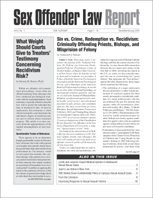Complete Issue
Author: Andrew Harris.
Source: Volume 13, Number 02, February/March 2012 , pp.17-32(16)

< previous article |return to table of contents
Abstract:
As part of SLR \'s ongoing series evaluating the evolution of sex offender civil commitment (SOCC) policies and programs over the past two decades, this issue presents the experiences of two states. The lead article by Freeman and Sandler describes the evolution of New York’s civil commitment policy and practice, from the initially failed attempts to civilly commit sex offenders through the state’s existing mental hygiene and correctional law, to the adoption of SOCC legislation in 2007, to the Office of Mental Health’s ongoing efforts to evaluate and refine its practices. This issue also includes a report on the November 2011 release of an analysis by the Virginia General Assembly’s Joint Legislative Audit and Review Commission (JLARC). This analysis, undertaken pursuant to legislator concerns over projected population growth and associated costs, depicts a program hampered by rigid and outdated decision rules that have failed to keep pace with emerging evidence. While these two case studies each provide a glimpse into the political and organizational dynamics of SOCC policies, they also present a broader series of questions concerning the scope and reach of the nation’s sex offender management laws. What are the respective roles of legislatures and implementing agencies in determining decision rules and processes? Do the statutory frameworks promote or impede the effective integration of evolving research evidence into daily practice? How can policymakers effectively balance the political demand for sweeping action with the responsibilities of creating targeted, efficient responses? These questions are certainly not unique to societal responses to sexual offending—assertion of legislative control over professional decision-making has emerged as a hallmark of contemporary criminal justice policy, as prominently reflected in the laws governing sentencing, immigration enforcement, drug policy, and many other areas. Yet, in the domain of sex offender management, policies over the past two decades have increasingly favored legislatively mandated, broad-based application of restrictions over approaches that vest decisional authority with judges, parole boards, and implementing agencies. This phenomenon has been manifested in many state laws governing registration and notification, residency restrictions, mandatory GPS monitoring, and Internet usage—provisions that serve as legitimate and essential elements of a comprehensive sex offender management strategy, but that also beckon for selectivity in their application. In this issue, we are pleased to include a brief article by Linda Baldwin and Scott Matson from the U.S. Department of Justice (DOJ) SMART Office, describing a DOJ initiative to improve the integration of research evidence into sex offender management practice. We look forward to hearing more from them as this initiative unfolds. Efforts to promote greater use of evidence in practice settings, however, require that we remain cognizant of the legal, political, and institutional conditions that may promote or impede the development of effective practice. Vesting just a bit more faith and authority in implementing agencies and practitioners is an important first step.Keywords: Sex Offender Civil Commitment
Affiliations:
1: Sex Offender Law Report Editor.